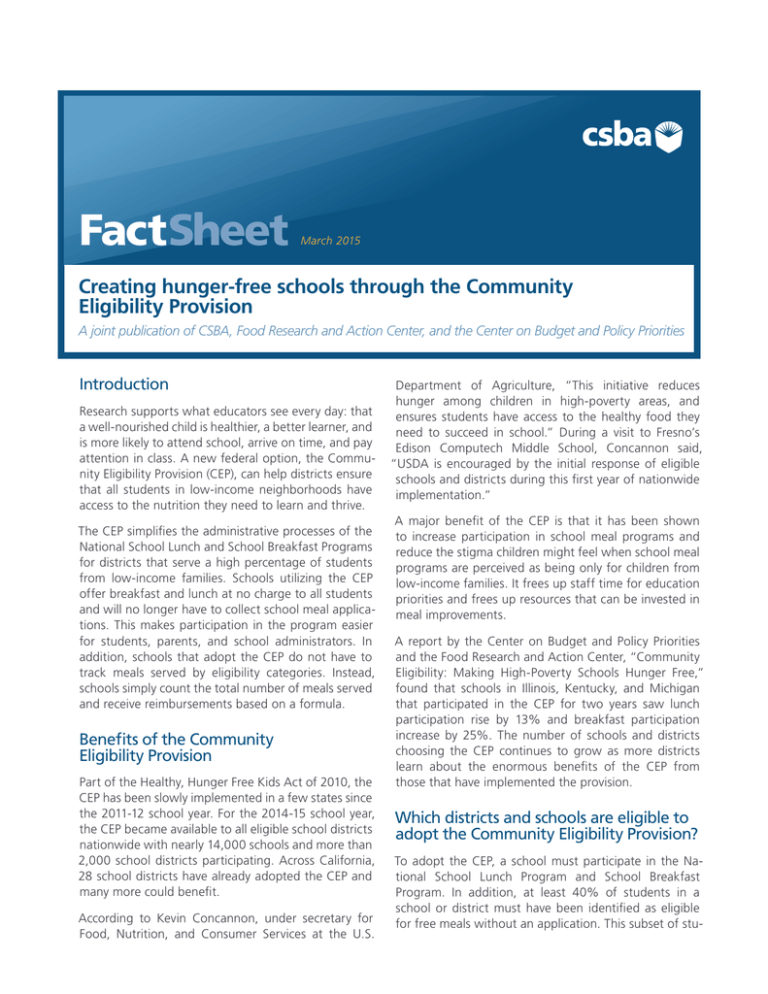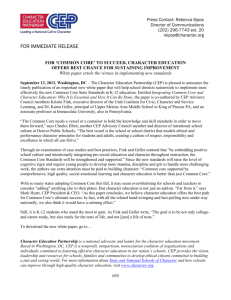Creating hunger-free schools through the Community Eligibility
advertisement

FactSheet March 2015 Creating hunger-free schools through the Community Eligibility Provision A joint publication of CSBA, Food Research and Action Center, and the Center on Budget and Policy Priorities Introduction Research supports what educators see every day: that a well-nourished child is healthier, a better learner, and is more likely to attend school, arrive on time, and pay attention in class. A new federal option, the Community Eligibility Provision (CEP), can help districts ensure that all students in low-income neighborhoods have access to the nutrition they need to learn and thrive. The CEP simplifies the administrative processes of the National School Lunch and School Breakfast Programs for districts that serve a high percentage of students from low-income families. Schools utilizing the CEP offer breakfast and lunch at no charge to all students and will no longer have to collect school meal applications. This makes participation in the program easier for students, parents, and school administrators. In addition, schools that adopt the CEP do not have to track meals served by eligibility categories. Instead, schools simply count the total number of meals served and receive reimbursements based on a formula. Benefits of the Community Eligibility Provision Part of the Healthy, Hunger Free Kids Act of 2010, the CEP has been slowly implemented in a few states since the 2011-12 school year. For the 2014-15 school year, the CEP became available to all eligible school districts nationwide with nearly 14,000 schools and more than 2,000 school districts participating. Across California, 28 school districts have already adopted the CEP and many more could benefit. According to Kevin Concannon, under secretary for Food, Nutrition, and Consumer Services at the U.S. Department of Agriculture, “This initiative reduces hunger among children in high-poverty areas, and ensures students have access to the healthy food they need to succeed in school.” During a visit to Fresno’s Edison Computech Middle School, Concannon said, “USDA is encouraged by the initial response of eligible schools and districts during this first year of nationwide implementation.” A major benefit of the CEP is that it has been shown to increase participation in school meal programs and reduce the stigma children might feel when school meal programs are perceived as being only for children from low-income families. It frees up staff time for education priorities and frees up resources that can be invested in meal improvements. A report by the Center on Budget and Policy Priorities and the Food Research and Action Center, “Community Eligibility: Making High-Poverty Schools Hunger Free,” found that schools in Illinois, Kentucky, and Michigan that participated in the CEP for two years saw lunch participation rise by 13% and breakfast participation increase by 25%. The number of schools and districts choosing the CEP continues to grow as more districts learn about the enormous benefits of the CEP from those that have implemented the provision. Which districts and schools are eligible to adopt the Community Eligibility Provision? To adopt the CEP, a school must participate in the National School Lunch Program and School Breakfast Program. In addition, at least 40% of students in a school or district must have been identified as eligible for free meals without an application. This subset of stu- dents from low-income families, referred to as “Identified Students,” includes: How the Community Eligibility Provision works »» Children who are automatically certified (through a data matching process known as direct certification) for free meals because they live in households that participate in CalFresh (known nationally as the Supplemental Nutrition Assistance Program), CalWORKS (known nationally as Temporary Assistance for Needy Families cash assistance), or Food Distribution Program on Indian Reservations (FDPIR), and »» Children who are certified for free school meals without submitting a school meal application because they are in foster care, enrolled in Head Start, homeless, runaway, or migrant. Schools that adopt the CEP will no longer have to collect school meal applications or track meals served by eligibility categories (i.e., free, reduced-price, paid). Instead, schools simply count the total number of meals served and reimbursements are provided based on a formula. Reimbursements are determined by multiplying the Identified Student Percentage by 1.6 to establish the percent of total breakfasts and lunches served that will be reimbursed at the highest federal rate, the “free” rate (capped at 100%). The remainder are reimbursed at the lower “paid” rate. By improving the data matching processes used to directly certify Identified Students, districts can increase their reimbursements under the CEP. Participating schools are guaranteed to receive the same reimbursement rate (or a higher one if the Identified Student Percentage increases) for four years. Districts decide whether to adopt the CEP and whether all or some of their schools will participate. Districts that implement the CEP districtwide benefit from the CEP’s administrative simplifications at all schools. But districts that aren’t eligible districtwide, or will not receive adequate reimbursements if they adopt the CEP districtwide, can implement the CEP in selected highpoverty schools. Many districts in other states have successfully adopted the CEP for some but not all schools and, where possible, expanded the CEP to additional schools over time. Districts can also choose whether schools participate in the CEP individually or as a group, based on the following criteria: »» Schools with 40% or more Identified Students may participate individually. »» Districts with 40% or more Identified Students may participate districtwide. »» Districts may choose to group schools any way they wish using their combined enrollment and combined number of Identified Students, as long as 40% or more of all students enrolled in schools in the group are Identified Students. An individual school within a group can have less than 40% Identified Students so long as the group as a whole exceeds 40% Identified Students. Grouping schools can increase federal reimbursements. There is no limit to the number of groups a district can have within the same school district; some schools can participate individually and some can participate as a group. CSBA | Fact Sheet | March 2015 Identified Student Percentage Meals Reimbursed at Free Rate Meals Reimbursed at Paid Rate 40% 64% 36% 45% 72% 28% 50% 80% 20% 55% 88% 12% 60% 96% 4% 62.5% and above 100% 0% The CEP is akin to Provision 2, a long-standing federal option, in that students are served meals at no charge, but the reimbursement structure differs. Districts can estimate their federal reimbursement under Provision 2 and the CEP to decide which rate is a better fit for individual schools. Some districts operate some schools under Provision 2 and others under the CEP. Options for participating districtwide or in groups of schools The various ways that school districts can choose to participate provides significant flexibility for school districts to make the finances work. Consider the following example. Sunnyside School District has 7,000 students 2 and 10 schools. There are 3,640 Identified Students in the district for a districtwide Identified Student Percentage of 52%. The district could participate districtwide and receive 83.2% of meals reimbursed at the free rate (52 x 1.6 = 83.2) and 16.8% at the paid rate. Districtwide School Enrollment Grouping Example A School Enrollment Identified Student Percentage Meals Reimbursed at Free Rate A 770 52% 83.2% B 510 59% 94.4% Identified Student Percentage Meals Reimbursed at Free Rate C 800 67% 100.0% D 520 50% 80.0% E 640 64% 100.0% A 770 52% 83.2% F 560 38% 60.8% B 510 59% 94.4% Total 3,800 55.8% Avg. 89.3% Avg. C 800 67% 100.0% D 520 50% 80.0% E 640 64% 100.0% F 560 38% 60.8% G 600 30% 48.0% H 630 62% 99.2% I 950 55% 88.0% J 1020 42% 67.2% Total 7,000 52% Avg. 83.2% Avg. If the district chooses not to participate districtwide, there are multiple options for grouping schools. When grouping, the Identified Student Percentage is calculated across the group as a whole by adding up the number of identified students across all the schools and dividing that total by the enrollment across all the schools. There are several reasons why a school district may want to group schools. For example, if a school district decides not to implement districtwide due to finances or because it is not eligible, the district may want to use the CEP in all the elementary schools instead (Example A). This may allow the school district to include schools that would not be eligible based on their Individual Identified Student percentage, as in Example A. In this scenario, six schools are grouped, including School F, which would not have been eligible on its own, resulting in nearly 90% of meals being reimbursed at the free rate. CSBA | Fact Sheet | March 2015 Additionally, schools can be grouped strategically to maximize the federal reimbursement the district would receive under the CEP. For example, if the district grouped the five highest poverty schools together, as in Example B, the district would be reimbursed for virtually all the meals served in these schools at the free rate. Grouping Example B School Enrollment Identified Student Percentage Meals Reimbursed at Free Rate B 510 59% 94.4% C 800 67% 100.0% E 640 64% 100.0% H 630 62% 99.2% I 950 55% 88.0% Total 3,530 61.2% Avg. 97.9% Avg. The Community Eligibility Provision and LCFF When schools adopt the CEP, they no longer collect school meal applications. However, to comply with the Local Control Funding Formula (LCFF) requirements, schools will still need to collect household income information every four years for each student who is not an Identified Student and for every newly enrolled student. Schools will do this using an alternative household income form. School districts in other states have successfully made the transition from collecting meal applications to collecting income data for purposes outside school meal programs without reductions in the number of students for whom income information 3 is obtained. The cost of this alternative data collection cannot be covered by cafeteria funds, but school nutrition staff can collect the information if their time is funded by other sources. The California Department of Education has provided significant guidance and sample forms for CEP schools (see additional resources). or the district as a whole and ensuring success once the district decides to opt in. »» Educate families and the school community about the CEP — Once the district has decided to adopt CEP, as community leaders, board members can play a crucial role in informing families and ensuring that the broader community understands the benefits of the program. »» Consider the eligibility and participation rates for school meals — Board members should inquire about the effectiveness of school meal programs, especially if school meal programs are reaching students whose main source of nutrition is provided by school meals. What percentage of students are eligible for free or reduced-price meals? What percentage of students participate in school meals? Does the school’s breakfast/lunch program appear in the district’s LCAP? »» Help adopt new processes to collect household income data — governing boards can play an instrumental role in helping the district adopt processes for collecting income data for purposes of complying with the LCFF. In addition, providing meals at no charge to all students to help ensure they are prepared to learn might be a strategy to be included in a district’s LCAP. How is the district collecting family income data? The CEP and Breakfast After the Bell In California, the School Breakfast Program is vastly underutilized. Only about half of low-income children who participate in the school lunch program also participate in school breakfast on an average day. Fortunately, there are a number of effective strategies that can be implemented in conjunction with the CEP to increase breakfast participation. Offering “breakfast after the bell” where students eat breakfast in the classroom at the start of the school day is the most effective of such strategies. Making breakfast part of the school day eliminates many of the barriers to participation in traditional breakfast programs where breakfast is offered in the cafeteria before school. Also, offering meals at no charge to all students through the CEP helps remove stigma for children from low-income families. Because schools only have to collect total meal counts, the CEP also allows for simplified implementation of service models where breakfast is served in the classroom or from grab-and-go kiosks in the hallway. Refer to CSBA’s Governance Brief: Starting a Breakfast After the Bell Program (see additional resources). How can a district adopt the Community Eligibility Provision? Once districts have considered the financial and administrative factors and determined that CEP is the right fit, obtaining CEP approval is straightforward. Superintendents interested in adopting CEP for the 2014-15 school year, can contact the California Department of Education for support through the process. In future years, districts will have the opportunity each spring to adopt the CEP and begin a four-year cycle the following school year. School board authority is not required by the CDE for adopting the CEP; however, some superintendents have gone to their board for a formal vote. Role of the governing board Districts should consider a number of factors when determining whether CEP would be a good fit. The governing board can play an important role in deciding whether the CEP will be beneficial for eligible schools CSBA | Fact Sheet | March 2015 Fresno Unified case study Fresno Unified School District was an early adopter of CEP and they are pleased with early results. “Our eyes are always open for programs and partnerships that will help our students overcome barriers to learning,” said Fresno Unified Superintendent Michael Hanson. “We will do everything in our power to help our students be as ready to learn as possible.” Fresno Unified Food Services Director Jose Alvarado first heard about the CEP through a bulletin from the CDE. His first thought was if the CEP eliminates the burden of paper work for families and result in more students eating healthy meals, then adopting the new program was a no-brainer. Alvarado gives a lot of credit to the CDE for their support and expertise throughout the process. The Department was generous with their time and connected Alvarado to districts across the country that had already implemented the CEP to give peer-to-peer coaching. 4 Adopting new programs can be challenging from a managerial and bureaucratic point of view, and Fresno’s adoption of the CEP, while smooth, did take effort. The biggest difficulty the district faced was analyzing different scenarios of which schools could be eligible for the CEP. While the CDE helped FUSD through this process too, Alvarado and the FUSD team did not dwell on the difficulties of implementation. “It really never entered our thoughts that taking on a new program would be hard. We knew that if we were successful we would be making everything easier for our staff, but most importantly reduce paperwork for families and streamline meal service operations for students,” Alvarado said. Superintendent Hanson kept the board informed with regular updates. They had questions from time to time, but were supportive from the start, Alvarado said. “We have made our vision for the district clear. We want to empower healthy and happy learners in Fresno Unified and we will supplement the resources we do not have as a district with innovative programs and creative partnerships. The CEP is absolutely within this vision,” Superintendent Hanson said. Additional resources CSBA Governance Brief: Starting a Breakfast After the Bell Program http://bit.ly/1FaprW8 Food Research and Action Center’s Community Eligibility Page http://bit.ly/1tCKJnu CBPP’s Community Eligibility Resources http://www.cbpp.org/childnutrition CDE’s Community Eligibility Resources http://www.cde.ca.gov/ls/nu/sn/cep.asp CDE’s Guidance on LCFF and CEP and Model Income Forms http://bit.ly/1I2l4ur USDA’s Community Eligibility Page http://1.usa.gov/1iP9FQI CSBA | Fact Sheet | March 2015 5




